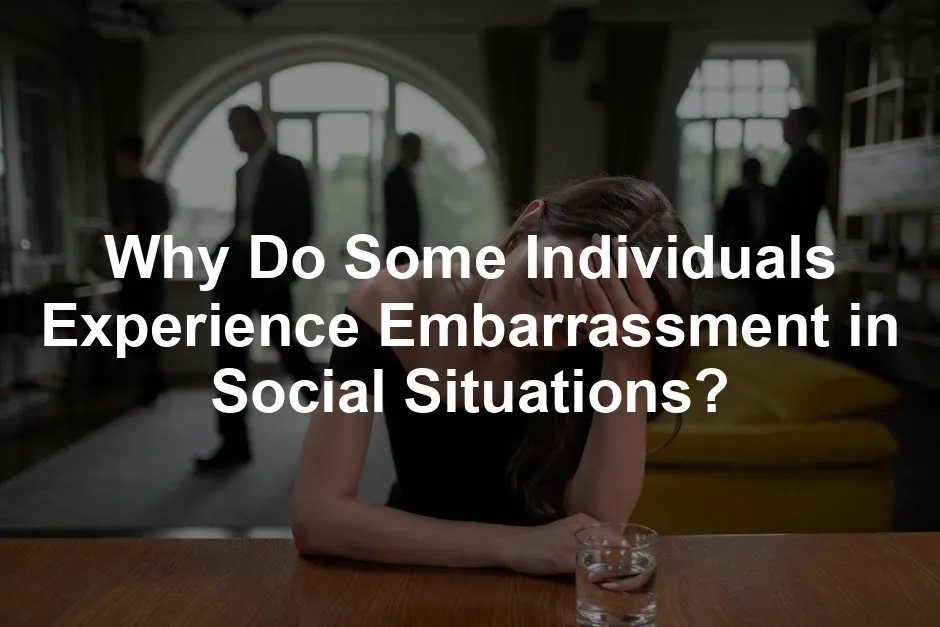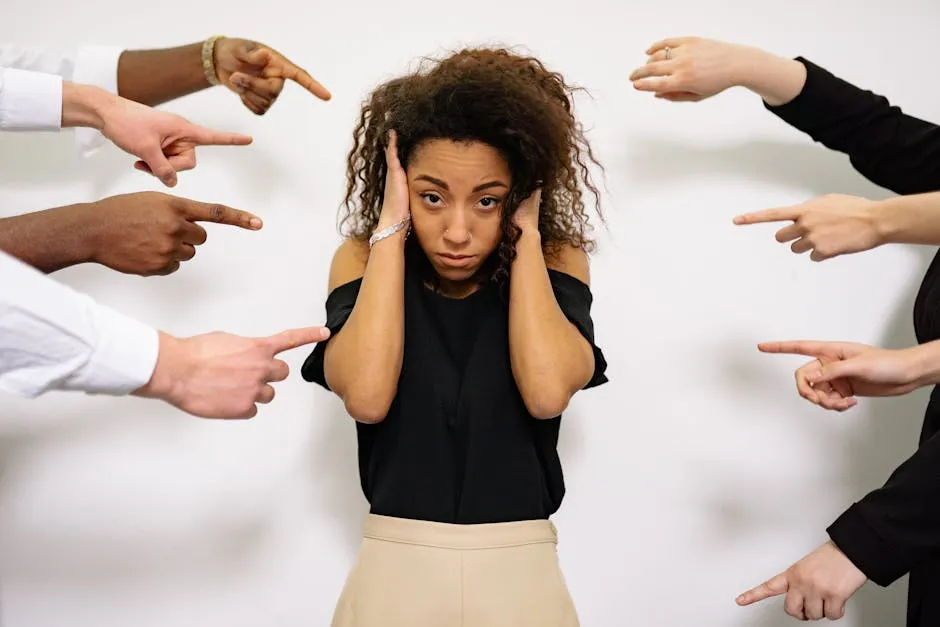
Why Do Some Individuals Experience Embarrassment in Social Situations?
Introduction
In the grand theater of life, where we all play our roles, embarrassment often takes center stage. Imagine the cringe-worthy moments you’ve experienced—perhaps a slip of the tongue during a presentation or an awkward dance move at a wedding. For some, these moments are fleeting, but for others, the fear of embarrassment can feel like a heavy cloak, draping over their social lives.
Embarrassment is not just a passing feeling; it’s a complex emotional experience. It can be triggered by various social situations, including mistakes, failures, or even just a simple miscommunication. This emotion often stems from our fear of being judged or scrutinized by others. For individuals who grapple with social anxiety, embarrassment can morph into a near-constant companion, making social interactions feel like walking on a tightrope.
The psychology of embarrassment is intriguing. It serves as a social signal, indicating that we recognize our missteps and prompting us to adjust our behavior. This is essential for maintaining social harmony. However, when the fear of embarrassment becomes overwhelming, it can lead to avoidance behaviors that disrupt daily life.
But what makes some individuals more susceptible to embarrassment than others? Is it merely a personality trait, or do deeper psychological factors play a role? Research suggests that a mix of personality traits, past experiences, and cultural pressures can significantly influence how we experience embarrassment. Understanding these layers can help us navigate our social lives with greater ease.
Interestingly, embarrassment isn’t always about personal failings. Sometimes, it can arise from witnessing the embarrassing moments of others—a phenomenon known as vicarious embarrassment. This highlights our innate empathy and the social bonds we share. Through this post, we’ll unpack the intricate web of embarrassment, exploring the reasons behind its grip on some individuals. By fostering understanding, perhaps we can all learn to embrace our awkwardness and stride confidently through the social landscape. After all, nobody’s perfect, and a little embarrassment is just part of being human!
If you’re looking to dive deeper into the psychology of emotions, you might want to consider reading The Gifts of Imperfection by Brené Brown. It’s an engaging read that emphasizes the importance of vulnerability and embracing our imperfections.
Understanding the fear of embarrassment is crucial, especially for those who struggle with it in social settings. Why do some people have a fear of public speaking (glossophobia)
The Social Function of Embarrassment
Embarrassment isn’t just an awkward moment; it’s social glue. It helps keep groups together. When we feel embarrassed, we signal that we recognize social norms. It shows we care about how our actions affect others. This acknowledgment fosters empathy and understanding among peers.
Consider a classic example: You accidentally trip at a party. As you laugh it off, others join in. This shared experience builds camaraderie. It reminds everyone that mistakes are part of life. When people express embarrassment, it often leads to prosocial behavior. They become more willing to help others and engage in acts of kindness.
Research supports this idea. Those who show embarrassment are seen as more trustworthy. They are perceived as better social partners. When we witness someone’s embarrassing moment, we often feel vicarious embarrassment. This reaction can encourage support and connection, proving that even uncomfortable emotions have their perks.
If you’re keen on improving your social skills, check out The Social Skills Guidebook by Chris MacLeod. It provides practical advice on navigating social situations and overcoming awkwardness.
Psychological Factors
The Role of Social Anxiety
Social anxiety disorder is more than simple shyness. It’s a debilitating condition affecting 7-13% of adults. Those with this disorder often experience intense fear of being judged negatively. This leads to avoidance of social situations, making everyday interactions feel daunting.
Individuals with social anxiety are more prone to embarrassment. The fear of being scrutinized amplifies their self-consciousness. Every social event transforms into a potential minefield. They might worry excessively about what others think. This constant anxiety can spiral into a cycle of embarrassment and avoidance.
Personality Traits and Sensitivity
Certain personality traits can increase embarrassment susceptibility. Introverts, for example, may find social interactions draining. Perfectionists often set impossibly high standards. When they inevitably fall short, embarrassment looms large. The inner critic becomes relentless, magnifying perceived failures.
This “inner critic” can distort self-perception. It makes social interactions feel like a series of performance evaluations. Negative self-talk can lead to heightened anxiety in social settings. Individuals may replay past interactions, obsessing over every misstep. This cycle further entrenches their embarrassment.
For those looking to cultivate self-compassion, I recommend Self-Compassion: The Proven Power of Being Kind to Yourself by Kristin Neff. It’s a great resource for learning to treat yourself with kindness, especially in moments of embarrassment.
The Influence of Past Experiences
Childhood experiences play a significant role in shaping how we respond to embarrassment. Kids who face bullying often develop heightened sensitivity to social judgment. Overprotective parenting can also stifle social confidence. These early experiences influence adult interactions, making embarrassment a lasting concern.
Research shows that negative social experiences in childhood can have long-term effects. Such individuals may carry the weight of past embarrassments into adulthood. This can lead to ongoing anxiety and self-doubt in social situations. Understanding these influences can help us recognize the roots of our emotional responses. It’s crucial to address these underlying issues to foster healthier social interactions.
Cultural and Social Context
Cultural Norms and Expectations
Embarrassment is not a one-size-fits-all emotion. It varies widely across cultures. For instance, in some Asian cultures, maintaining harmony and avoiding conflict is paramount. Here, public embarrassment can feel like a personal failure, impacting not just the individual but the entire family. In contrast, Western cultures may have a more light-hearted approach. Here, awkward moments can lead to shared laughter, creating stronger social bonds.
These cultural norms shape our reactions to embarrassment. In collectivist societies, individuals may fear losing face, which can amplify feelings of shame. This pressure can lead to avoidance of social situations, creating a cycle of fear and embarrassment. On the other hand, in more individualistic cultures, people might use humor to cope, viewing embarrassment as a humorous quirk of life. This difference in perspective can significantly influence how embarrassment manifests and is managed.
Societal expectations can further complicate matters. For example, in professional settings, a slip-up can lead to greater embarrassment due to perceived competence standards. The pressure to conform to these norms can heighten feelings of self-consciousness. In such environments, the stakes feel high, and the fear of judgment can be paralyzing. Navigating these cultural waters requires a keen awareness of social cues and norms, which can be exhausting for those prone to embarrassment.
Vicarious Embarrassment
Vicarious embarrassment, also known as empathetic or third-party embarrassment, is a fascinating psychological phenomenon. It occurs when we feel embarrassed for someone else. You know that feeling when you witness a friend trip on stage? You cringe, almost as if it happened to you. This reaction showcases our ability to empathize with others. It’s a testament to our social nature.
The psychological basis for vicarious embarrassment lies in empathy. When we observe someone facing an embarrassing situation, our brain’s empathy circuits activate. This can lead to physical symptoms, like sweating or blushing. Interestingly, people with higher empathy levels often experience this feeling more intensely. It’s as if their emotional radar is finely tuned to the social dynamics around them.
In everyday life, vicarious embarrassment plays a significant role in social interactions. It can foster connection and understanding among friends and family. For example, when you laugh at your friend’s karaoke mishap, it not only lightens the mood but also strengthens your bond. However, it can also lead to discomfort. The fear of being embarrassed on behalf of another can result in avoidance behaviors, like skipping social gatherings where such scenarios might occur. This emotional response illustrates how our social connections shape our experiences of embarrassment, both for ourselves and others.
Long-term Strategies
Embarrassment can feel like an unwelcome guest at social gatherings. However, there are effective long-term strategies to manage it. One powerful method is exposure therapy. This involves gradually facing the situations that trigger your embarrassment. Imagine purposely singing karaoke, even if you’re not the next pop star. This approach can help reduce social anxiety. The more you practice, the more comfortable you become. Over time, that fear will feel like a distant memory, not a looming specter.
Another helpful tool is journaling. Writing about embarrassing moments can help you process them. It allows you to reflect on your feelings without judgment. You can identify patterns and gain insights into your triggers. This practice enhances self-awareness, making you better prepared for future situations.
Mindfulness is another effective technique. It encourages you to stay present and observe your thoughts without getting carried away. When you feel embarrassment creeping in, take a deep breath. Acknowledge the feeling, then gently redirect your focus. This can build resilience over time, making you less reactive to social faux pas.
Combined, exposure therapy, journaling, and mindfulness cultivate a stronger sense of self. They empower you to face embarrassment head-on, transforming it into an opportunity for growth and connection. Embrace these strategies and watch your confidence flourish in social settings. And if you want to explore mindfulness further, consider Mindfulness for Beginners by Jon Kabat-Zinn, which is a fantastic introduction to mindfulness practices.
FAQs
What is the difference between embarrassment and shame?
Embarrassment and shame often dance closely together but are fundamentally different. Embarrassment is a fleeting emotional response to a specific social misstep. It’s that red-faced moment when you trip in public or forget someone’s name at a party. It’s generally tied to social norms and how we think we are perceived by others. Shame, however, is deeper and more pervasive. It’s about feeling flawed or inadequate at a fundamental level. While embarrassment is about a specific action, shame is often tied to our self-worth. For instance, if you embarrass yourself during a presentation, you might feel embarrassed. But if you internalize that moment and believe you are unworthy or incompetent, that’s shame rearing its ugly head. Understanding this distinction can help individuals navigate their feelings better and foster healthier social interactions.
Can embarrassment lead to social anxiety?
Yes, embarrassment can indeed pave the way for social anxiety. Think of embarrassment as the gateway drug to a more complex emotional landscape. Frequent embarrassing experiences can contribute to the development of social anxiety disorder, where the fear of negative evaluation becomes pervasive. Imagine feeling embarrassed at a social event. That feeling might linger, creating anxiety about future interactions. You may start avoiding social situations altogether, fearing that the next embarrassment is just around the corner. According to research, individuals with social anxiety often report heightened sensitivity to embarrassing moments. This cycle of embarrassment and avoidance can significantly impact day-to-day life, leading to isolation and missed opportunities.
How can I help someone who is easily embarrassed?
Supporting a friend or family member who struggles with embarrassment can be a delicate task. Here are a few tips to lend a hand: 1. **Listen and Validate:** Sometimes, just being there and listening can ease their anxiety. Acknowledge their feelings without judgment. 2. **Encourage Humor:** Help them find the lighter side of embarrassing moments. Laughter can be a great healer! 3. **Practice Together:** If they fear social situations, consider role-playing or attending social gatherings together. This can provide a sense of security. 4. **Promote Self-Compassion:** Remind them that everyone has awkward moments. Encouraging self-kindness can diminish the weight of embarrassment. 5. **Seek Professional Help:** If their embarrassment significantly impacts their life, suggest they consider therapy. A mental health professional can provide effective coping strategies.
Is embarrassment a universal emotion?
Embarrassment is indeed a universal emotion, but its expression varies across cultures. While everyone experiences embarrassment, how it’s perceived and dealt with can be culturally specific. In some cultures, embarrassment might be met with laughter and camaraderie, while in others, it could lead to feelings of shame and isolation. For example, in collectivist cultures, maintaining harmony is crucial. Here, public embarrassment can carry heavy implications not just for the individual but for their family or group. Conversely, in more individualistic societies, people might openly laugh off embarrassing moments, seeing them as a shared human experience. Understanding these cultural nuances can enhance our interaction with people from different backgrounds.
What are some common triggers for embarrassment?
Embarrassment can spring from various everyday situations. Here are some classic scenarios that often lead to those cringe-worthy feelings: – **Public Speaking:** Forgetting your lines or stumbling over words can be mortifying. – **Making Mistakes:** Whether it’s spilling a drink or hitting “reply all” on an embarrassing email, mistakes can trigger embarrassment. – **Social Faux Pas:** Misreading social cues, like making an inappropriate joke, can lead to that flush of embarrassment. – **Wardrobe Malfunctions:** From ripped pants to a visible tag, clothing mishaps can leave you feeling exposed. – **Awkward Interactions:** Forgetting someone’s name or walking into the wrong room can create a sense of discomfort. In essence, embarrassment can sneak up on anyone, often when we least expect it. Recognizing these triggers is the first step toward managing this universal emotion.

Please let us know what you think about our content by leaving a comment down below!

Thank you for reading till here 🙂 And remember, if you’re feeling a bit frazzled, check out A Mindfulness Guide for the Frazzled by Ruby Wax. It’s a delightful read that provides humor and wisdom for those chaotic moments in life.
All images from Pexels




